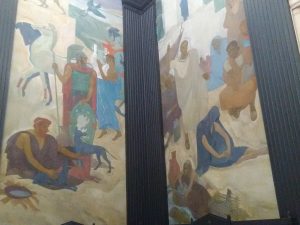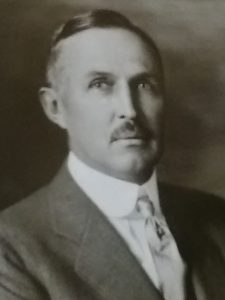Exhibit honors Lake Forest Library history
By Gregory Harutunian For Chronicle Media — December 27, 2017
The Lake Forest Library dome, made of leaded copper, before it was covered for protection. (Photo by Gregory Harutunian/for Chronicle Media)
The distinctive dome atop the Lake Forest Library has been covered to protect the rotunda area and circulation desk underneath, from water seepage.
Made of leaded copper material, it is tentatively slated for replacement next summer due to the aging process. The dome, itself a 1980s replacement of the original 1931 construction, affirms the history involved with the building.
“The design of the building is classical, as if you’re entering a Greek temple through the foyer and the rotunda area, beneath the dome,” said Joy Schmoll, the Lake Forest Library Marketing Coordinator. “The dome needs to be replaced, due to age. Its substructure has aged, and we put on a protective covering … it’s slated to be replaced next summer.
“This is such a beautiful and historic building, with a true charm, and I’ve been told that patrons like the aisles of book shelves … they’re almost like a labyrinth,” she said. “This is a very comfortable place.”
The library’s evolution and history is on display in the foyer with an exhibition of artifacts, legends, and visual media.
According to library documents, the building “was designed by architect Edwin H. Clark, the designer of the Brookfield Zoo and the Winnetka Village Hall. (It) was dedicated on June 7, 1931. It was built as a library, and given as a gift to the City of Lake Forest, by Laura Shedd and Helen Shedd Reed Keith, daughters of former Marshall Field store president John G. Shedd. They donated the building in memory of Mrs. Keith’s first husband, Kersey Coates Reed. The archer’s face is a likeness of Mr. Reed.”

Mural panels in the library’s rotunda area, depicting the Ancient Greeks, were painted by Nikolai Remisoff in 1931. (Photo by Gregory Harutunian/for Chronicle Media)
Schmoll noted, “The Chicago connections are really interesting, and there are many. Kersey Coates Reed was the husband of Helen Shedd, the daughter of John G. Shedd, of the Shedd Aquarium, and the president of Marshall Field’s, after the namesake has passed on. In the rotunda area, there’s a bas-relief sculpture with his face, as a way of honoring him for his efforts with the library. He loved books, I’m told.”
The artist, Oskar J. W. Hansen, was a Norwegian émigré in 1910 that was educated at the Northwestern University divinity school. After a career as a merchant seaman, joining the French Foreign Legion in North Africa, and serving in the U.S. Army, during World War II, He turned “to sculpting, working in bronze, marble, and wood,” according to library documentation.
“Hansen is best known for designing heroic, large-scale sculptures that characteristically decorated Works Progress Administration projects in the 1930s and 1940s. He created many of the sculptures on, and around, Hoover Dam, including ‘Winged Figures of the Republic,’ which are over 30 feet high, and used more than four tons of bronze.”
Also in the rotunda are a series of large-scale mural panels depicting the Ancient Greeks.
“The murals are art-deco to coincide with the building design, and also features elements of the Byzantine era,” said Schmoll. “They were painted by a Russian émigré, Nikolai Remisoff, in 1931. He lived in Chicago, starting in 1928, and had a patron in Arthur E. Hamill, a Lake Forest resident, and the library’s President. He did murals and paintings for the Hamill mansion, and was promoted to work on other prestigious projects.”

The face of Kersey Coates Reed (left), was used as a model for the bas-relief sculpture of an archer, in the library’s rotunda. (Photo by Gregory Harutunian/for Chronicle Media)
Remisoff’s 10-year stay in Chicago also encompassed designing and creating sets for the civic ballet and opera companies, before embarking on a career in Hollywood. There, he designed sets, costumes, and entire productions for movies and television shows. His style has been called “Russian Vogue.”
“This is what makes the history and the stories of the library so vibrant and interesting,” Schmoll said. “We’re always finding some new information that was either lost, or forgotten about. Bringing it back to light is a lot of fun, and we encourage patrons to visit and investigate it for themselves.”
The exhibition of library history runs through the end of January.
— Exhibit honors Lake Forest Library history —



